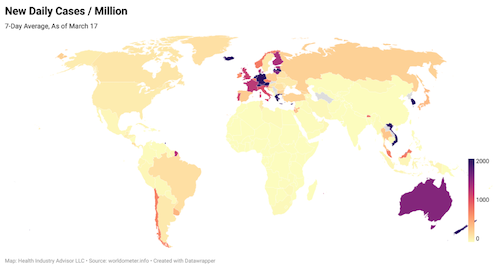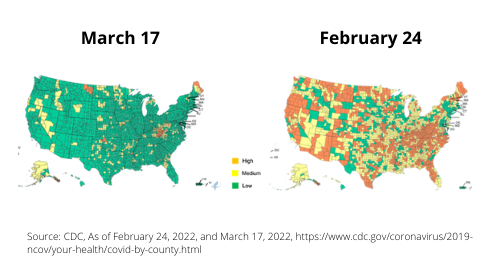By Mark Van Sumeren
March 21, 2022 – The United States suffered a substantial infection wave in late December and early January, fueled by the Omicron BA.1 variant. However, while the newer BA.2 variant rages across Europe and Asia-Pacific, the U.S. has avoided a renewed surge – at least thus far.
Europe and Asia-Pacific represent the current epicenters of the BA.2 infection spread. The circumstances behind these two epicenters differ. Europe faces its surge despite relatively high rates of prior infection and ubiquitous vaccinations. Asia-Pacific countries are discovering that their strict containment efforts have little effect on evading the Omicron variants (BA.1 and BA.2). For instance, Brunei, Hong Kong, New Zealand, and South Korea recorded new infection rates per capita last week among the highest in the world.
China reported five times more cases last week than a week earlier despite its strict containment measures.

Vaccinations seem to have lessened the severity of the infections. Across Europe, death rates remain lower than with earlier variants. Conversely, Hong Kong struggles with the highest Covid death rate of all countries- by a significant margin. Unfortunately, the elderly in Hong Kong resisted getting vaccinated and now suffer tragic consequences.
The United States enjoys a much better situation currently. Last week, cases, hospitalizations, and deaths reverted to the low levels last seen eight months ago – and at no other time since the pandemic began:
- Cases fell 21% last week and 74% in the past month
- Covid admissions and census dropped 25% last week and 75% in the past month. Covid patients occupy fewer than one in sixteen hospital beds; in January, this had approached one of every two beds
- Deaths declined 24% last week and 60% in the past month.
Effectively, the entire country (98%) resides in a community deemed “Low” or “Medium” by the Centers for Disease Control and Prevention in its Covid Community Level rating scheme. Just three weeks ago, only 70% earned this designation. Under this construct, the CDC relaxes most masking recommendations in Low- or Medium-designated communities.

How has this country sidestepped this latest variant, and how long can it do so?
This morning, Harvard epidemiologist Bill Hanage offered his perspective on these questions on Andy Slavitt’s In the Bubble podcast. Hanage noted that the BA.2 variant has circulated in the United States for several months already. However, BA.2 met two conditions in this country different from what existed in Europe. First, the BA.1 variant that spread in the United States had evolved slightly from the BA.1 variant prevalent in Europe. In his opinion, the differences were sufficient to enhance resistance to reinfection from the BA.2 variant.
Second, the United States may have saved itself by relaxing restrictions earlier than most European countries. In Hanage’s view, Europe’s current challenge results from lousy timing – it eased rules just as the BA.2 variant had readied to strike. Meeting previously relaxed restrictions in the U.S., BA.2 seems to have spread more naturally, rather than spiking as it has in recently opened Europe.
So, should we anticipate another surge here in this country? Hanage believes we should, though he expects more of a modest bubble than a spike. Also, a recent ensemble forecast predicted that cases could begin to rise again three weeks from now.
